Marketing Report: Evaluating Starbucks and Tesco Marketing Techniques
VerifiedAdded on 2020/10/04
|13
|3035
|35
Report
AI Summary
This report provides a comprehensive analysis of the marketing strategies employed by Starbucks and Tesco. It begins with an introduction to the concept of marketing, followed by an evaluation of various marketing techniques used by both companies, including branding, brand extension, and relationship marketing. The report also examines the limitations and constraints of marketing, with reference to legal requirements such as the Sales of Goods Act, Consumer Protection from Unfair Trading 2008, Consumer Credit Act, Consumer Protection (Distance Selling), and the Data Protection Act. Furthermore, it explores the use of marketing research, including primary and secondary research methods, and the utilization of marketing information and data through SWOT and PESTLE analyses. The report also delves into market segmentation, identifying target customers for specific products, and concludes by developing a coherent marketing mix for a new product or service. The report provides valuable insights into how marketing is used by successful businesses and the factors influencing their strategies.

Introduction to MK
Paraphrase This Document
Need a fresh take? Get an instant paraphrase of this document with our AI Paraphraser
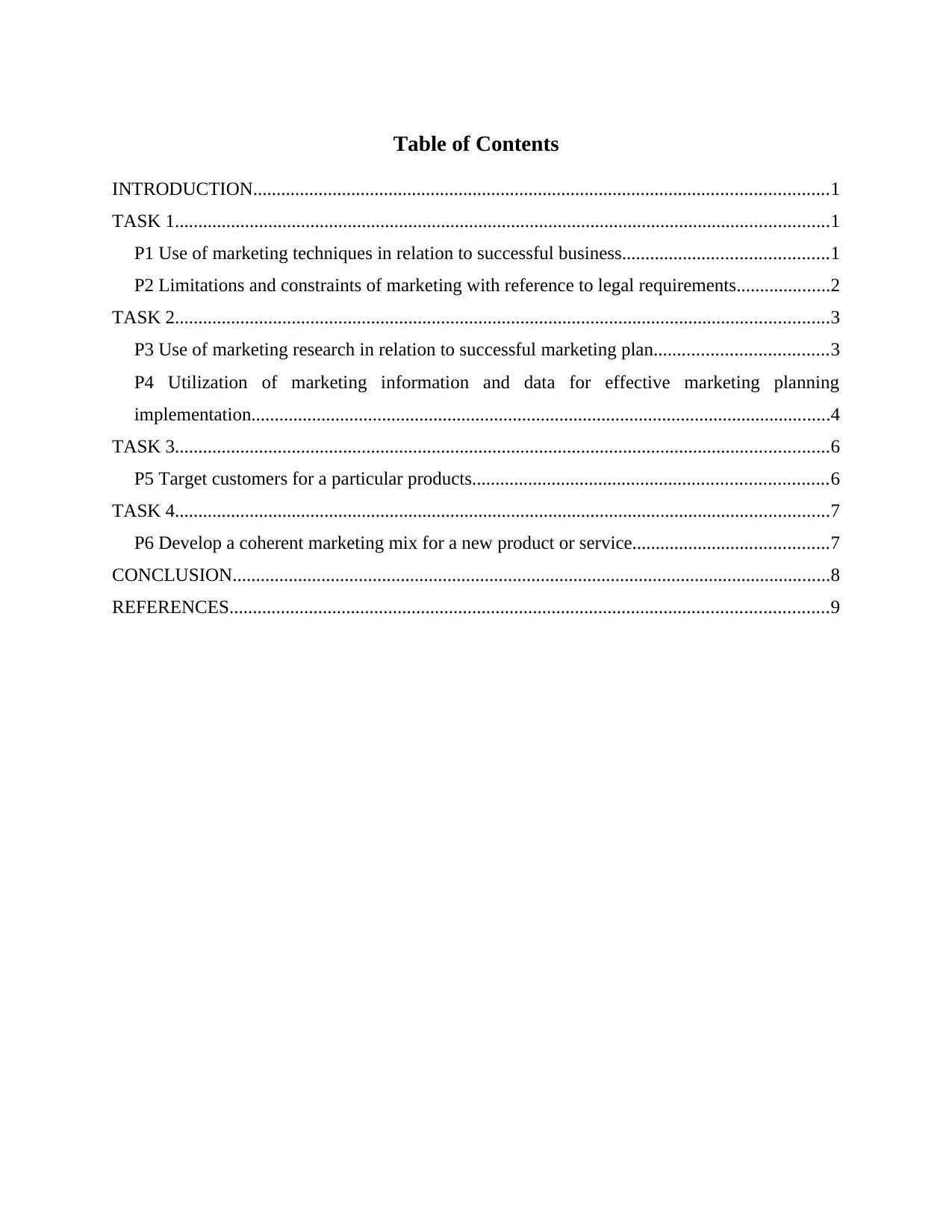
Table of Contents
INTRODUCTION...........................................................................................................................1
TASK 1............................................................................................................................................1
P1 Use of marketing techniques in relation to successful business............................................1
P2 Limitations and constraints of marketing with reference to legal requirements....................2
TASK 2............................................................................................................................................3
P3 Use of marketing research in relation to successful marketing plan.....................................3
P4 Utilization of marketing information and data for effective marketing planning
implementation............................................................................................................................4
TASK 3............................................................................................................................................6
P5 Target customers for a particular products............................................................................6
TASK 4............................................................................................................................................7
P6 Develop a coherent marketing mix for a new product or service..........................................7
CONCLUSION................................................................................................................................8
REFERENCES................................................................................................................................9
INTRODUCTION...........................................................................................................................1
TASK 1............................................................................................................................................1
P1 Use of marketing techniques in relation to successful business............................................1
P2 Limitations and constraints of marketing with reference to legal requirements....................2
TASK 2............................................................................................................................................3
P3 Use of marketing research in relation to successful marketing plan.....................................3
P4 Utilization of marketing information and data for effective marketing planning
implementation............................................................................................................................4
TASK 3............................................................................................................................................6
P5 Target customers for a particular products............................................................................6
TASK 4............................................................................................................................................7
P6 Develop a coherent marketing mix for a new product or service..........................................7
CONCLUSION................................................................................................................................8
REFERENCES................................................................................................................................9

⊘ This is a preview!⊘
Do you want full access?
Subscribe today to unlock all pages.

Trusted by 1+ million students worldwide
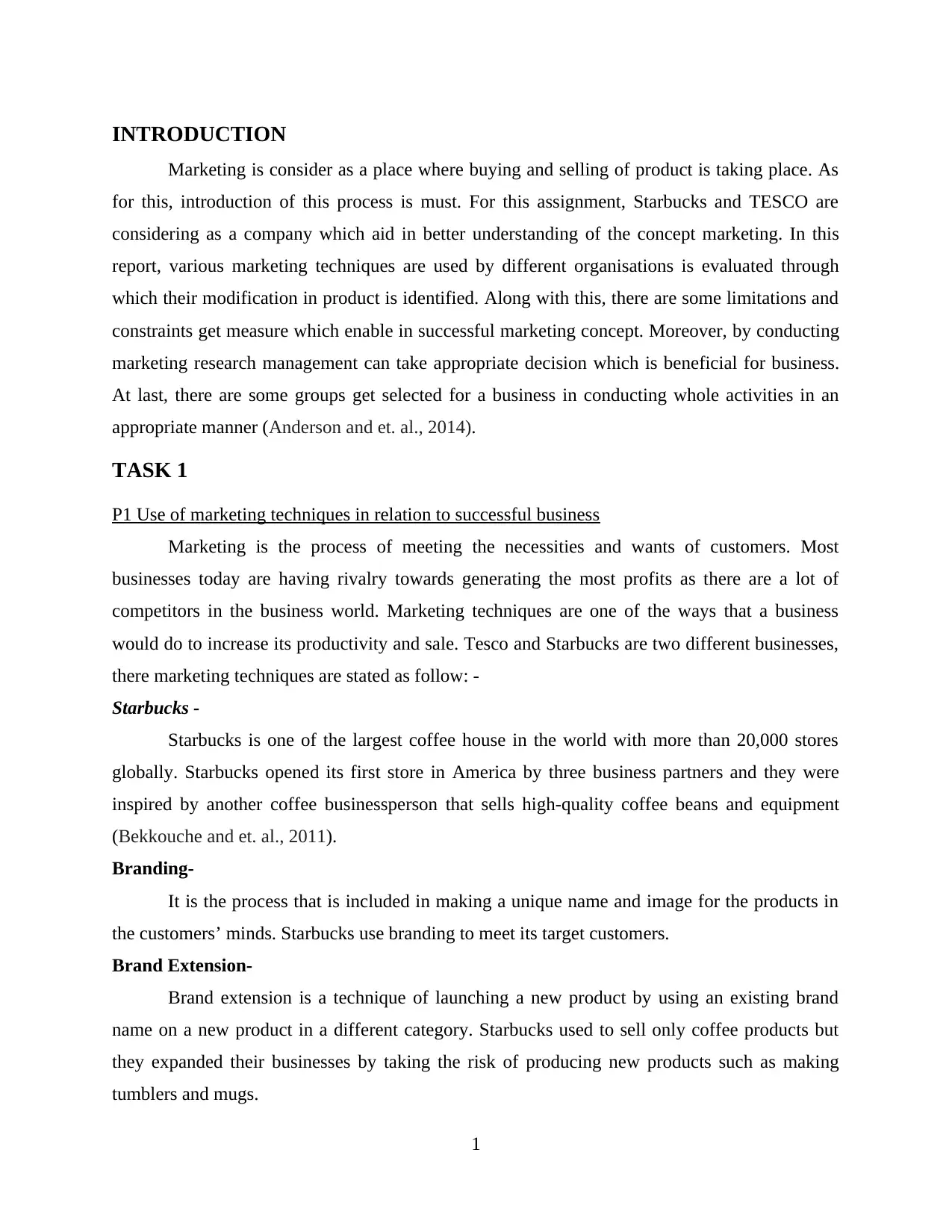
INTRODUCTION
Marketing is consider as a place where buying and selling of product is taking place. As
for this, introduction of this process is must. For this assignment, Starbucks and TESCO are
considering as a company which aid in better understanding of the concept marketing. In this
report, various marketing techniques are used by different organisations is evaluated through
which their modification in product is identified. Along with this, there are some limitations and
constraints get measure which enable in successful marketing concept. Moreover, by conducting
marketing research management can take appropriate decision which is beneficial for business.
At last, there are some groups get selected for a business in conducting whole activities in an
appropriate manner (Anderson and et. al., 2014).
TASK 1
P1 Use of marketing techniques in relation to successful business
Marketing is the process of meeting the necessities and wants of customers. Most
businesses today are having rivalry towards generating the most profits as there are a lot of
competitors in the business world. Marketing techniques are one of the ways that a business
would do to increase its productivity and sale. Tesco and Starbucks are two different businesses,
there marketing techniques are stated as follow: -
Starbucks -
Starbucks is one of the largest coffee house in the world with more than 20,000 stores
globally. Starbucks opened its first store in America by three business partners and they were
inspired by another coffee businessperson that sells high-quality coffee beans and equipment
(Bekkouche and et. al., 2011).
Branding-
It is the process that is included in making a unique name and image for the products in
the customers’ minds. Starbucks use branding to meet its target customers.
Brand Extension-
Brand extension is a technique of launching a new product by using an existing brand
name on a new product in a different category. Starbucks used to sell only coffee products but
they expanded their businesses by taking the risk of producing new products such as making
tumblers and mugs.
1
Marketing is consider as a place where buying and selling of product is taking place. As
for this, introduction of this process is must. For this assignment, Starbucks and TESCO are
considering as a company which aid in better understanding of the concept marketing. In this
report, various marketing techniques are used by different organisations is evaluated through
which their modification in product is identified. Along with this, there are some limitations and
constraints get measure which enable in successful marketing concept. Moreover, by conducting
marketing research management can take appropriate decision which is beneficial for business.
At last, there are some groups get selected for a business in conducting whole activities in an
appropriate manner (Anderson and et. al., 2014).
TASK 1
P1 Use of marketing techniques in relation to successful business
Marketing is the process of meeting the necessities and wants of customers. Most
businesses today are having rivalry towards generating the most profits as there are a lot of
competitors in the business world. Marketing techniques are one of the ways that a business
would do to increase its productivity and sale. Tesco and Starbucks are two different businesses,
there marketing techniques are stated as follow: -
Starbucks -
Starbucks is one of the largest coffee house in the world with more than 20,000 stores
globally. Starbucks opened its first store in America by three business partners and they were
inspired by another coffee businessperson that sells high-quality coffee beans and equipment
(Bekkouche and et. al., 2011).
Branding-
It is the process that is included in making a unique name and image for the products in
the customers’ minds. Starbucks use branding to meet its target customers.
Brand Extension-
Brand extension is a technique of launching a new product by using an existing brand
name on a new product in a different category. Starbucks used to sell only coffee products but
they expanded their businesses by taking the risk of producing new products such as making
tumblers and mugs.
1
Paraphrase This Document
Need a fresh take? Get an instant paraphrase of this document with our AI Paraphraser
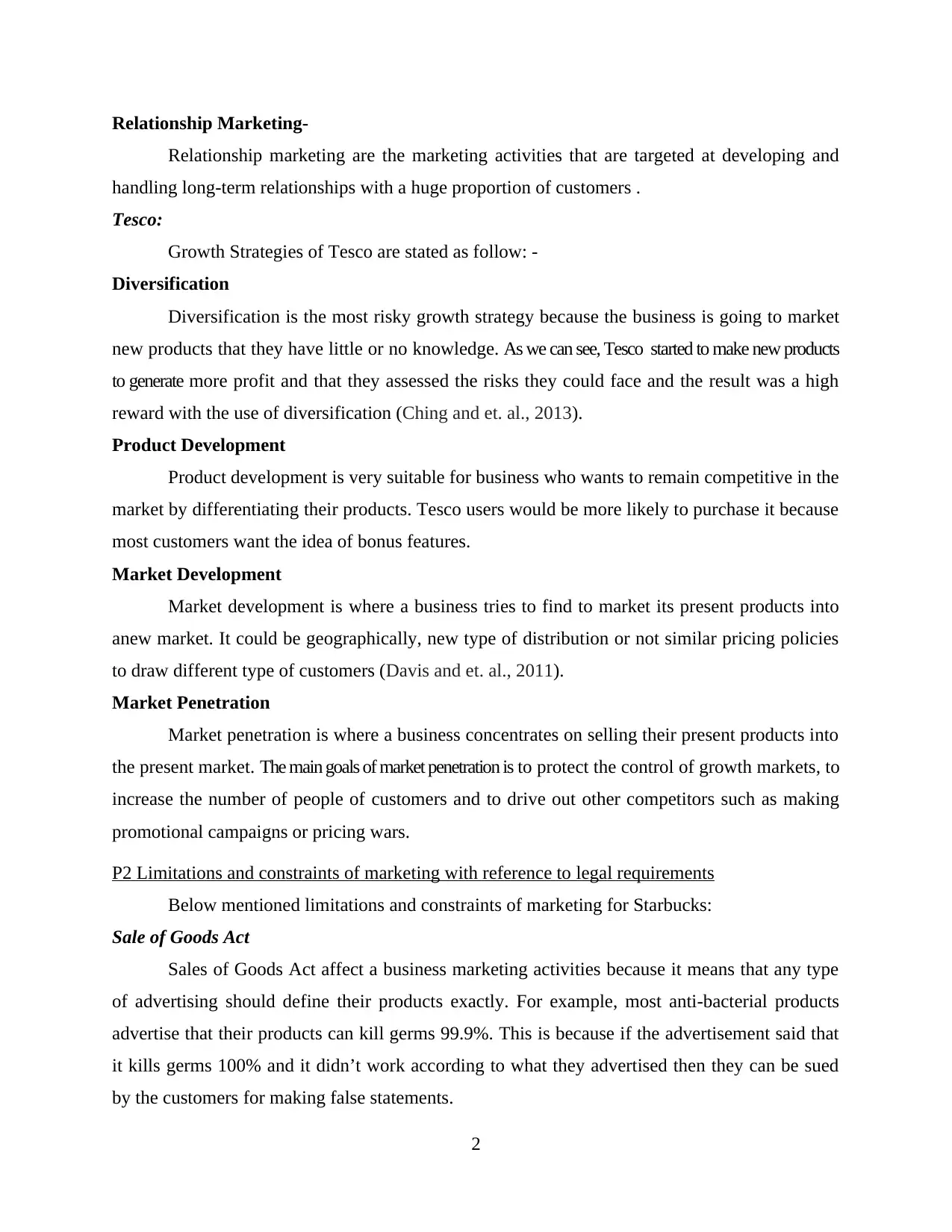
Relationship Marketing-
Relationship marketing are the marketing activities that are targeted at developing and
handling long-term relationships with a huge proportion of customers .
Tesco:
Growth Strategies of Tesco are stated as follow: -
Diversification
Diversification is the most risky growth strategy because the business is going to market
new products that they have little or no knowledge. As we can see, Tesco started to make new products
to generate more profit and that they assessed the risks they could face and the result was a high
reward with the use of diversification (Ching and et. al., 2013).
Product Development
Product development is very suitable for business who wants to remain competitive in the
market by differentiating their products. Tesco users would be more likely to purchase it because
most customers want the idea of bonus features.
Market Development
Market development is where a business tries to find to market its present products into
anew market. It could be geographically, new type of distribution or not similar pricing policies
to draw different type of customers (Davis and et. al., 2011).
Market Penetration
Market penetration is where a business concentrates on selling their present products into
the present market. The main goals of market penetration is to protect the control of growth markets, to
increase the number of people of customers and to drive out other competitors such as making
promotional campaigns or pricing wars.
P2 Limitations and constraints of marketing with reference to legal requirements
Below mentioned limitations and constraints of marketing for Starbucks:
Sale of Goods Act
Sales of Goods Act affect a business marketing activities because it means that any type
of advertising should define their products exactly. For example, most anti-bacterial products
advertise that their products can kill germs 99.9%. This is because if the advertisement said that
it kills germs 100% and it didn’t work according to what they advertised then they can be sued
by the customers for making false statements.
2
Relationship marketing are the marketing activities that are targeted at developing and
handling long-term relationships with a huge proportion of customers .
Tesco:
Growth Strategies of Tesco are stated as follow: -
Diversification
Diversification is the most risky growth strategy because the business is going to market
new products that they have little or no knowledge. As we can see, Tesco started to make new products
to generate more profit and that they assessed the risks they could face and the result was a high
reward with the use of diversification (Ching and et. al., 2013).
Product Development
Product development is very suitable for business who wants to remain competitive in the
market by differentiating their products. Tesco users would be more likely to purchase it because
most customers want the idea of bonus features.
Market Development
Market development is where a business tries to find to market its present products into
anew market. It could be geographically, new type of distribution or not similar pricing policies
to draw different type of customers (Davis and et. al., 2011).
Market Penetration
Market penetration is where a business concentrates on selling their present products into
the present market. The main goals of market penetration is to protect the control of growth markets, to
increase the number of people of customers and to drive out other competitors such as making
promotional campaigns or pricing wars.
P2 Limitations and constraints of marketing with reference to legal requirements
Below mentioned limitations and constraints of marketing for Starbucks:
Sale of Goods Act
Sales of Goods Act affect a business marketing activities because it means that any type
of advertising should define their products exactly. For example, most anti-bacterial products
advertise that their products can kill germs 99.9%. This is because if the advertisement said that
it kills germs 100% and it didn’t work according to what they advertised then they can be sued
by the customers for making false statements.
2
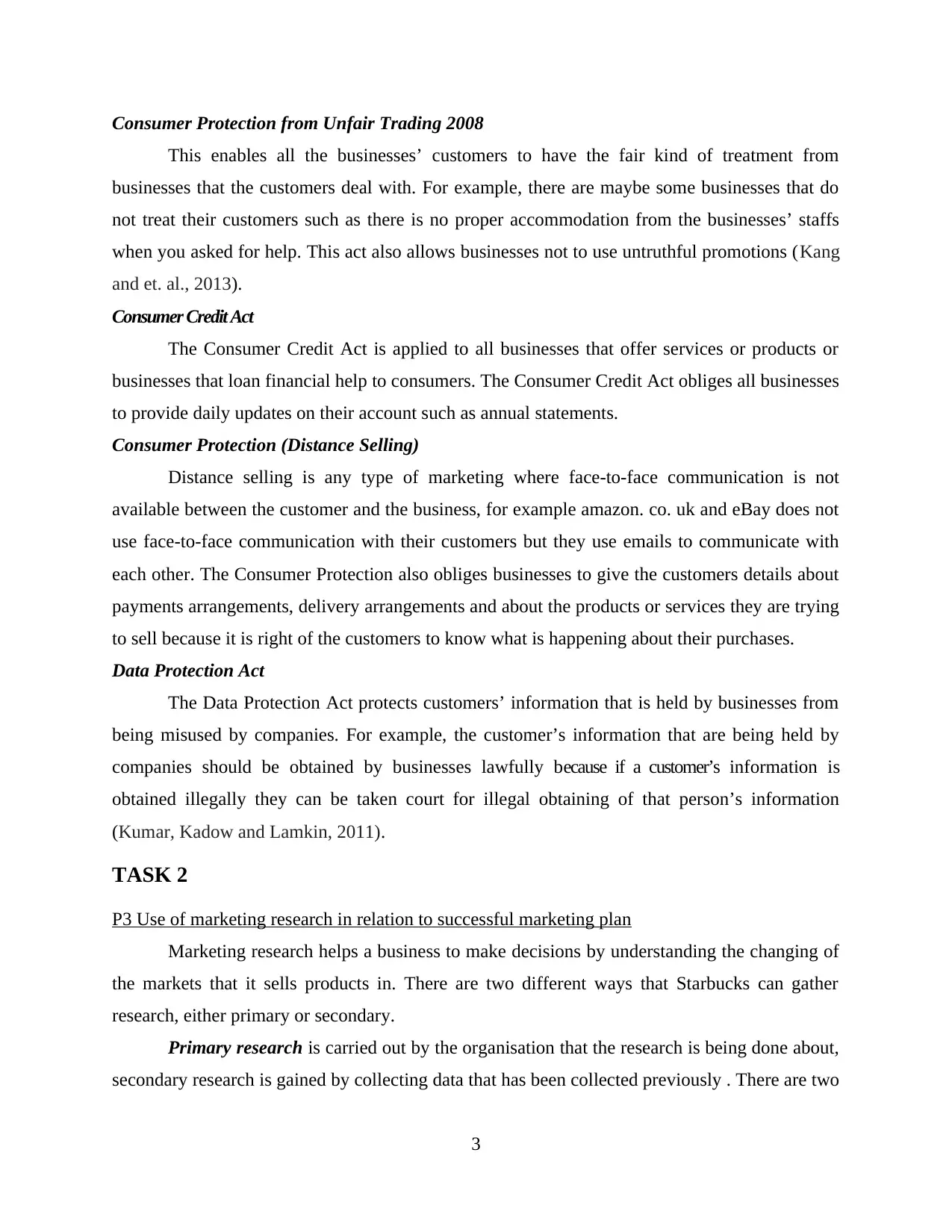
Consumer Protection from Unfair Trading 2008
This enables all the businesses’ customers to have the fair kind of treatment from
businesses that the customers deal with. For example, there are maybe some businesses that do
not treat their customers such as there is no proper accommodation from the businesses’ staffs
when you asked for help. This act also allows businesses not to use untruthful promotions (Kang
and et. al., 2013).
Consumer Credit Act
The Consumer Credit Act is applied to all businesses that offer services or products or
businesses that loan financial help to consumers. The Consumer Credit Act obliges all businesses
to provide daily updates on their account such as annual statements.
Consumer Protection (Distance Selling)
Distance selling is any type of marketing where face-to-face communication is not
available between the customer and the business, for example amazon. co. uk and eBay does not
use face-to-face communication with their customers but they use emails to communicate with
each other. The Consumer Protection also obliges businesses to give the customers details about
payments arrangements, delivery arrangements and about the products or services they are trying
to sell because it is right of the customers to know what is happening about their purchases.
Data Protection Act
The Data Protection Act protects customers’ information that is held by businesses from
being misused by companies. For example, the customer’s information that are being held by
companies should be obtained by businesses lawfully because if a customer’s information is
obtained illegally they can be taken court for illegal obtaining of that person’s information
(Kumar, Kadow and Lamkin, 2011).
TASK 2
P3 Use of marketing research in relation to successful marketing plan
Marketing research helps a business to make decisions by understanding the changing of
the markets that it sells products in. There are two different ways that Starbucks can gather
research, either primary or secondary.
Primary research is carried out by the organisation that the research is being done about,
secondary research is gained by collecting data that has been collected previously . There are two
3
This enables all the businesses’ customers to have the fair kind of treatment from
businesses that the customers deal with. For example, there are maybe some businesses that do
not treat their customers such as there is no proper accommodation from the businesses’ staffs
when you asked for help. This act also allows businesses not to use untruthful promotions (Kang
and et. al., 2013).
Consumer Credit Act
The Consumer Credit Act is applied to all businesses that offer services or products or
businesses that loan financial help to consumers. The Consumer Credit Act obliges all businesses
to provide daily updates on their account such as annual statements.
Consumer Protection (Distance Selling)
Distance selling is any type of marketing where face-to-face communication is not
available between the customer and the business, for example amazon. co. uk and eBay does not
use face-to-face communication with their customers but they use emails to communicate with
each other. The Consumer Protection also obliges businesses to give the customers details about
payments arrangements, delivery arrangements and about the products or services they are trying
to sell because it is right of the customers to know what is happening about their purchases.
Data Protection Act
The Data Protection Act protects customers’ information that is held by businesses from
being misused by companies. For example, the customer’s information that are being held by
companies should be obtained by businesses lawfully because if a customer’s information is
obtained illegally they can be taken court for illegal obtaining of that person’s information
(Kumar, Kadow and Lamkin, 2011).
TASK 2
P3 Use of marketing research in relation to successful marketing plan
Marketing research helps a business to make decisions by understanding the changing of
the markets that it sells products in. There are two different ways that Starbucks can gather
research, either primary or secondary.
Primary research is carried out by the organisation that the research is being done about,
secondary research is gained by collecting data that has been collected previously . There are two
3
⊘ This is a preview!⊘
Do you want full access?
Subscribe today to unlock all pages.

Trusted by 1+ million students worldwide
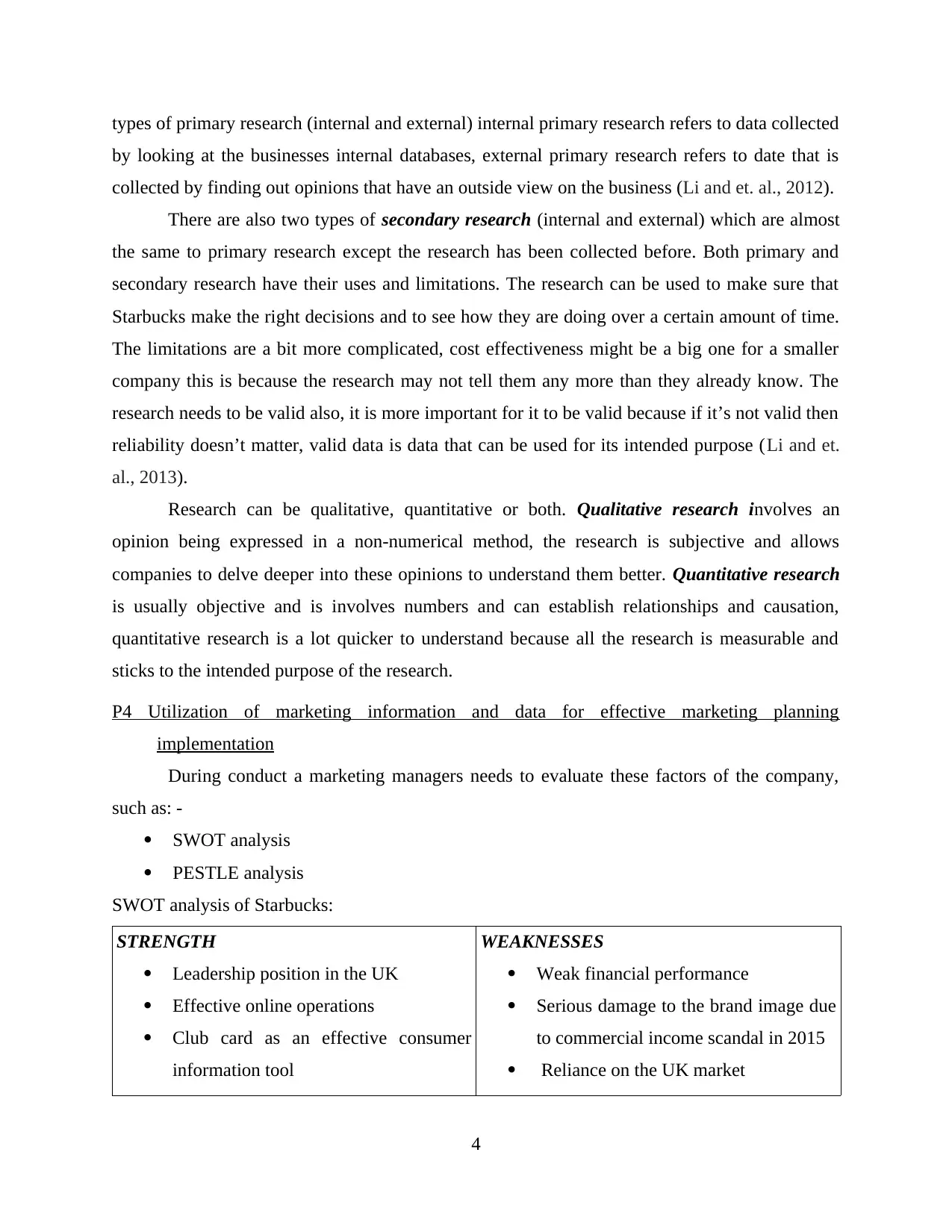
types of primary research (internal and external) internal primary research refers to data collected
by looking at the businesses internal databases, external primary research refers to date that is
collected by finding out opinions that have an outside view on the business (Li and et. al., 2012).
There are also two types of secondary research (internal and external) which are almost
the same to primary research except the research has been collected before. Both primary and
secondary research have their uses and limitations. The research can be used to make sure that
Starbucks make the right decisions and to see how they are doing over a certain amount of time.
The limitations are a bit more complicated, cost effectiveness might be a big one for a smaller
company this is because the research may not tell them any more than they already know. The
research needs to be valid also, it is more important for it to be valid because if it’s not valid then
reliability doesn’t matter, valid data is data that can be used for its intended purpose (Li and et.
al., 2013).
Research can be qualitative, quantitative or both. Qualitative research involves an
opinion being expressed in a non-numerical method, the research is subjective and allows
companies to delve deeper into these opinions to understand them better. Quantitative research
is usually objective and is involves numbers and can establish relationships and causation,
quantitative research is a lot quicker to understand because all the research is measurable and
sticks to the intended purpose of the research.
P4 Utilization of marketing information and data for effective marketing planning
implementation
During conduct a marketing managers needs to evaluate these factors of the company,
such as: -
SWOT analysis
PESTLE analysis
SWOT analysis of Starbucks:
STRENGTH
Leadership position in the UK
Effective online operations
Club card as an effective consumer
information tool
WEAKNESSES
Weak financial performance
Serious damage to the brand image due
to commercial income scandal in 2015
Reliance on the UK market
4
by looking at the businesses internal databases, external primary research refers to date that is
collected by finding out opinions that have an outside view on the business (Li and et. al., 2012).
There are also two types of secondary research (internal and external) which are almost
the same to primary research except the research has been collected before. Both primary and
secondary research have their uses and limitations. The research can be used to make sure that
Starbucks make the right decisions and to see how they are doing over a certain amount of time.
The limitations are a bit more complicated, cost effectiveness might be a big one for a smaller
company this is because the research may not tell them any more than they already know. The
research needs to be valid also, it is more important for it to be valid because if it’s not valid then
reliability doesn’t matter, valid data is data that can be used for its intended purpose (Li and et.
al., 2013).
Research can be qualitative, quantitative or both. Qualitative research involves an
opinion being expressed in a non-numerical method, the research is subjective and allows
companies to delve deeper into these opinions to understand them better. Quantitative research
is usually objective and is involves numbers and can establish relationships and causation,
quantitative research is a lot quicker to understand because all the research is measurable and
sticks to the intended purpose of the research.
P4 Utilization of marketing information and data for effective marketing planning
implementation
During conduct a marketing managers needs to evaluate these factors of the company,
such as: -
SWOT analysis
PESTLE analysis
SWOT analysis of Starbucks:
STRENGTH
Leadership position in the UK
Effective online operations
Club card as an effective consumer
information tool
WEAKNESSES
Weak financial performance
Serious damage to the brand image due
to commercial income scandal in 2015
Reliance on the UK market
4
Paraphrase This Document
Need a fresh take? Get an instant paraphrase of this document with our AI Paraphraser
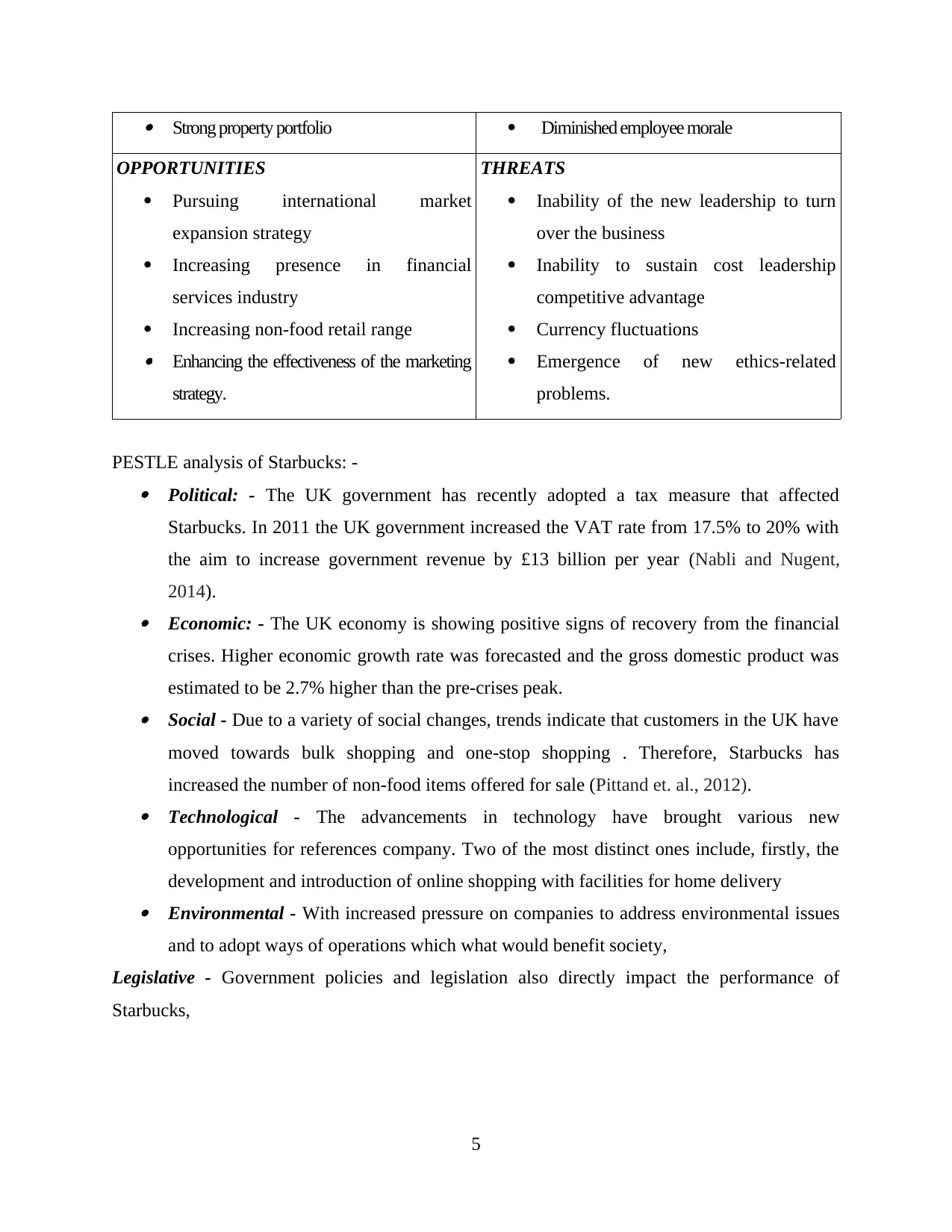
Strong property portfolio Diminished employee morale
OPPORTUNITIES
Pursuing international market
expansion strategy
Increasing presence in financial
services industry
Increasing non-food retail range Enhancing the effectiveness of the marketing
strategy.
THREATS
Inability of the new leadership to turn
over the business
Inability to sustain cost leadership
competitive advantage
Currency fluctuations
Emergence of new ethics-related
problems.
PESTLE analysis of Starbucks: - Political: - The UK government has recently adopted a tax measure that affected
Starbucks. In 2011 the UK government increased the VAT rate from 17.5% to 20% with
the aim to increase government revenue by £13 billion per year (Nabli and Nugent,
2014). Economic: - The UK economy is showing positive signs of recovery from the financial
crises. Higher economic growth rate was forecasted and the gross domestic product was
estimated to be 2.7% higher than the pre-crises peak. Social - Due to a variety of social changes, trends indicate that customers in the UK have
moved towards bulk shopping and one-stop shopping . Therefore, Starbucks has
increased the number of non-food items offered for sale (Pittand et. al., 2012). Technological - The advancements in technology have brought various new
opportunities for references company. Two of the most distinct ones include, firstly, the
development and introduction of online shopping with facilities for home delivery Environmental - With increased pressure on companies to address environmental issues
and to adopt ways of operations which what would benefit society,
Legislative - Government policies and legislation also directly impact the performance of
Starbucks,
5
OPPORTUNITIES
Pursuing international market
expansion strategy
Increasing presence in financial
services industry
Increasing non-food retail range Enhancing the effectiveness of the marketing
strategy.
THREATS
Inability of the new leadership to turn
over the business
Inability to sustain cost leadership
competitive advantage
Currency fluctuations
Emergence of new ethics-related
problems.
PESTLE analysis of Starbucks: - Political: - The UK government has recently adopted a tax measure that affected
Starbucks. In 2011 the UK government increased the VAT rate from 17.5% to 20% with
the aim to increase government revenue by £13 billion per year (Nabli and Nugent,
2014). Economic: - The UK economy is showing positive signs of recovery from the financial
crises. Higher economic growth rate was forecasted and the gross domestic product was
estimated to be 2.7% higher than the pre-crises peak. Social - Due to a variety of social changes, trends indicate that customers in the UK have
moved towards bulk shopping and one-stop shopping . Therefore, Starbucks has
increased the number of non-food items offered for sale (Pittand et. al., 2012). Technological - The advancements in technology have brought various new
opportunities for references company. Two of the most distinct ones include, firstly, the
development and introduction of online shopping with facilities for home delivery Environmental - With increased pressure on companies to address environmental issues
and to adopt ways of operations which what would benefit society,
Legislative - Government policies and legislation also directly impact the performance of
Starbucks,
5
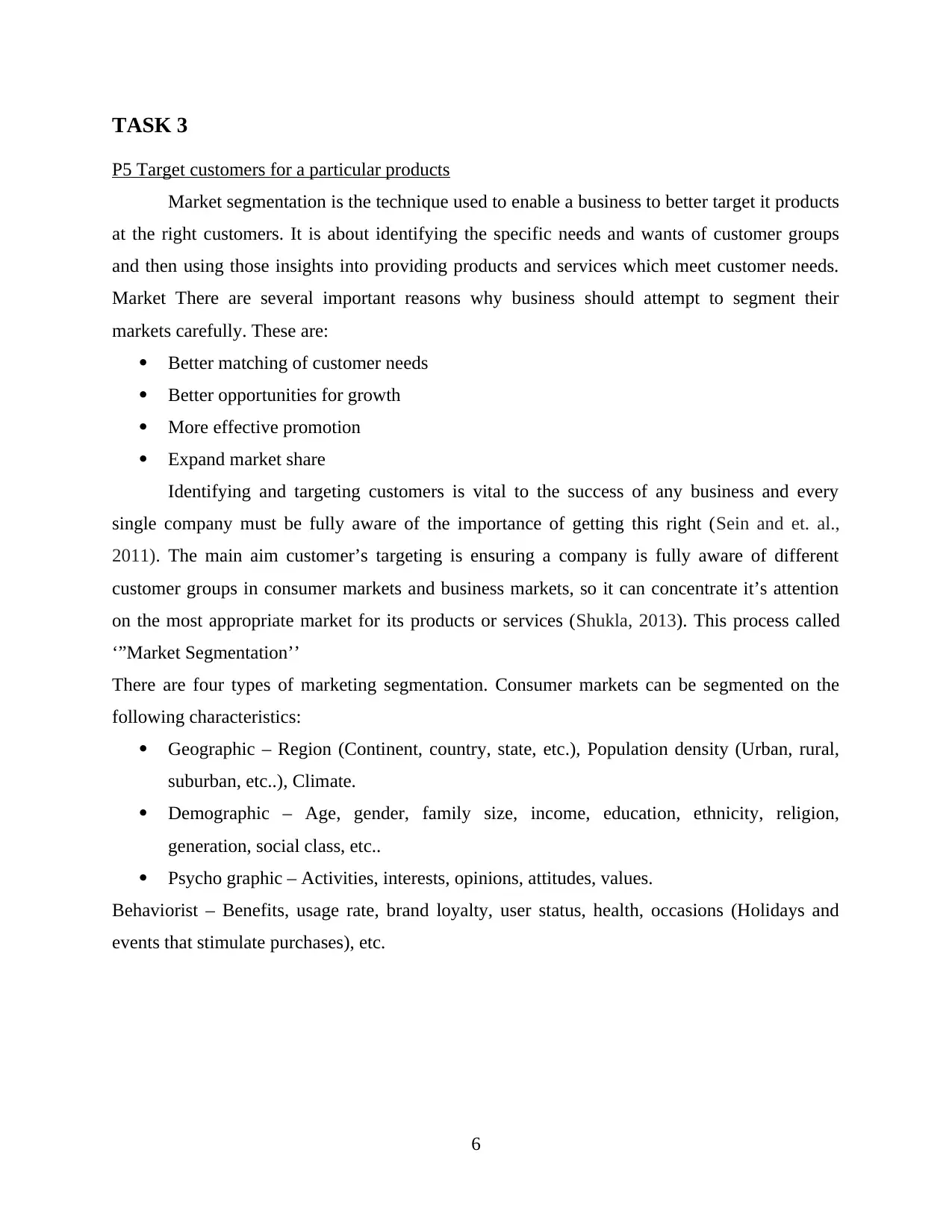
TASK 3
P5 Target customers for a particular products
Market segmentation is the technique used to enable a business to better target it products
at the right customers. It is about identifying the specific needs and wants of customer groups
and then using those insights into providing products and services which meet customer needs.
Market There are several important reasons why business should attempt to segment their
markets carefully. These are:
Better matching of customer needs
Better opportunities for growth
More effective promotion
Expand market share
Identifying and targeting customers is vital to the success of any business and every
single company must be fully aware of the importance of getting this right (Sein and et. al.,
2011). The main aim customer’s targeting is ensuring a company is fully aware of different
customer groups in consumer markets and business markets, so it can concentrate it’s attention
on the most appropriate market for its products or services (Shukla, 2013). This process called
‘”Market Segmentation’’
There are four types of marketing segmentation. Consumer markets can be segmented on the
following characteristics:
Geographic – Region (Continent, country, state, etc.), Population density (Urban, rural,
suburban, etc..), Climate.
Demographic – Age, gender, family size, income, education, ethnicity, religion,
generation, social class, etc..
Psycho graphic – Activities, interests, opinions, attitudes, values.
Behaviorist – Benefits, usage rate, brand loyalty, user status, health, occasions (Holidays and
events that stimulate purchases), etc.
6
P5 Target customers for a particular products
Market segmentation is the technique used to enable a business to better target it products
at the right customers. It is about identifying the specific needs and wants of customer groups
and then using those insights into providing products and services which meet customer needs.
Market There are several important reasons why business should attempt to segment their
markets carefully. These are:
Better matching of customer needs
Better opportunities for growth
More effective promotion
Expand market share
Identifying and targeting customers is vital to the success of any business and every
single company must be fully aware of the importance of getting this right (Sein and et. al.,
2011). The main aim customer’s targeting is ensuring a company is fully aware of different
customer groups in consumer markets and business markets, so it can concentrate it’s attention
on the most appropriate market for its products or services (Shukla, 2013). This process called
‘”Market Segmentation’’
There are four types of marketing segmentation. Consumer markets can be segmented on the
following characteristics:
Geographic – Region (Continent, country, state, etc.), Population density (Urban, rural,
suburban, etc..), Climate.
Demographic – Age, gender, family size, income, education, ethnicity, religion,
generation, social class, etc..
Psycho graphic – Activities, interests, opinions, attitudes, values.
Behaviorist – Benefits, usage rate, brand loyalty, user status, health, occasions (Holidays and
events that stimulate purchases), etc.
6
⊘ This is a preview!⊘
Do you want full access?
Subscribe today to unlock all pages.

Trusted by 1+ million students worldwide
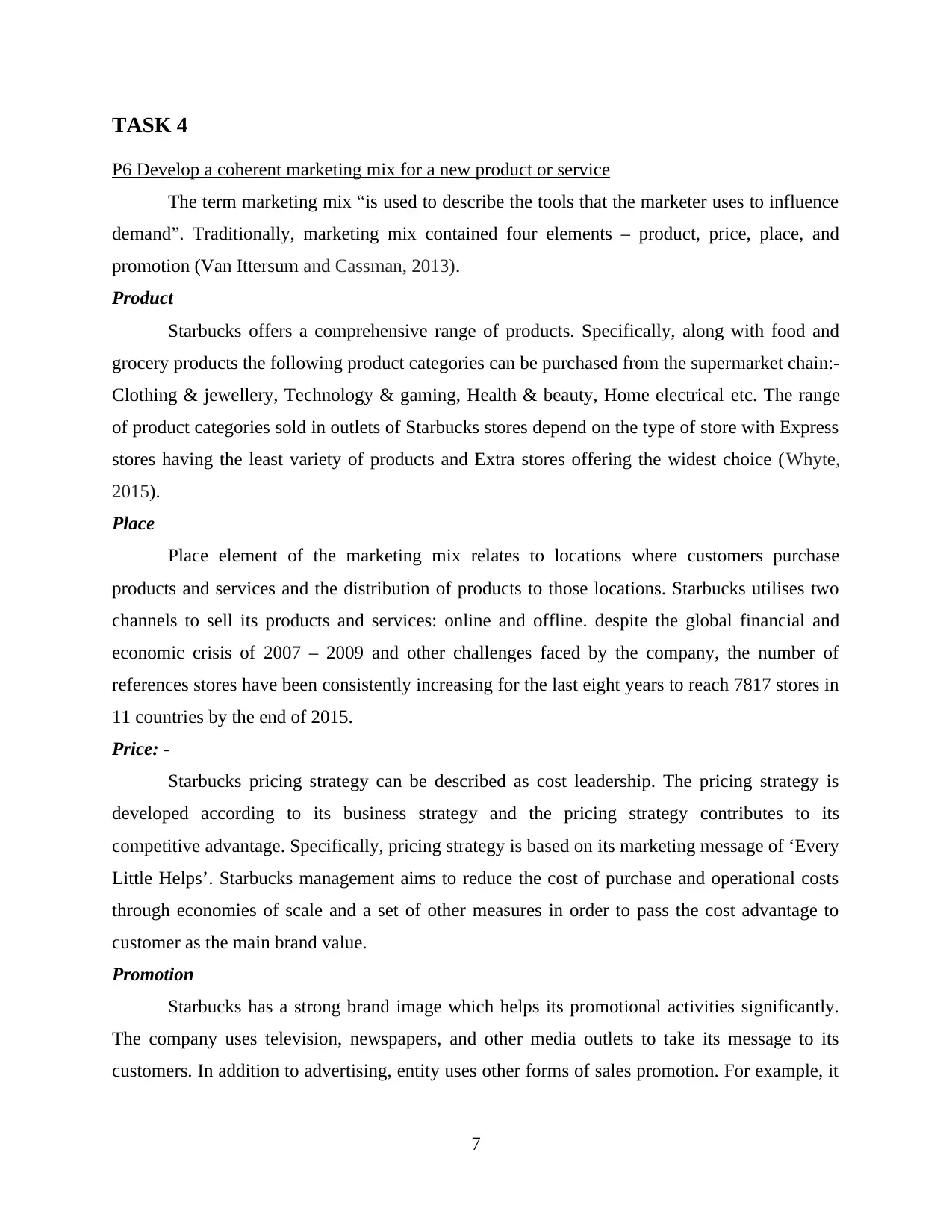
TASK 4
P6 Develop a coherent marketing mix for a new product or service
The term marketing mix “is used to describe the tools that the marketer uses to influence
demand”. Traditionally, marketing mix contained four elements – product, price, place, and
promotion (Van Ittersum and Cassman, 2013).
Product
Starbucks offers a comprehensive range of products. Specifically, along with food and
grocery products the following product categories can be purchased from the supermarket chain:-
Clothing & jewellery, Technology & gaming, Health & beauty, Home electrical etc. The range
of product categories sold in outlets of Starbucks stores depend on the type of store with Express
stores having the least variety of products and Extra stores offering the widest choice (Whyte,
2015).
Place
Place element of the marketing mix relates to locations where customers purchase
products and services and the distribution of products to those locations. Starbucks utilises two
channels to sell its products and services: online and offline. despite the global financial and
economic crisis of 2007 – 2009 and other challenges faced by the company, the number of
references stores have been consistently increasing for the last eight years to reach 7817 stores in
11 countries by the end of 2015.
Price: -
Starbucks pricing strategy can be described as cost leadership. The pricing strategy is
developed according to its business strategy and the pricing strategy contributes to its
competitive advantage. Specifically, pricing strategy is based on its marketing message of ‘Every
Little Helps’. Starbucks management aims to reduce the cost of purchase and operational costs
through economies of scale and a set of other measures in order to pass the cost advantage to
customer as the main brand value.
Promotion
Starbucks has a strong brand image which helps its promotional activities significantly.
The company uses television, newspapers, and other media outlets to take its message to its
customers. In addition to advertising, entity uses other forms of sales promotion. For example, it
7
P6 Develop a coherent marketing mix for a new product or service
The term marketing mix “is used to describe the tools that the marketer uses to influence
demand”. Traditionally, marketing mix contained four elements – product, price, place, and
promotion (Van Ittersum and Cassman, 2013).
Product
Starbucks offers a comprehensive range of products. Specifically, along with food and
grocery products the following product categories can be purchased from the supermarket chain:-
Clothing & jewellery, Technology & gaming, Health & beauty, Home electrical etc. The range
of product categories sold in outlets of Starbucks stores depend on the type of store with Express
stores having the least variety of products and Extra stores offering the widest choice (Whyte,
2015).
Place
Place element of the marketing mix relates to locations where customers purchase
products and services and the distribution of products to those locations. Starbucks utilises two
channels to sell its products and services: online and offline. despite the global financial and
economic crisis of 2007 – 2009 and other challenges faced by the company, the number of
references stores have been consistently increasing for the last eight years to reach 7817 stores in
11 countries by the end of 2015.
Price: -
Starbucks pricing strategy can be described as cost leadership. The pricing strategy is
developed according to its business strategy and the pricing strategy contributes to its
competitive advantage. Specifically, pricing strategy is based on its marketing message of ‘Every
Little Helps’. Starbucks management aims to reduce the cost of purchase and operational costs
through economies of scale and a set of other measures in order to pass the cost advantage to
customer as the main brand value.
Promotion
Starbucks has a strong brand image which helps its promotional activities significantly.
The company uses television, newspapers, and other media outlets to take its message to its
customers. In addition to advertising, entity uses other forms of sales promotion. For example, it
7
Paraphrase This Document
Need a fresh take? Get an instant paraphrase of this document with our AI Paraphraser
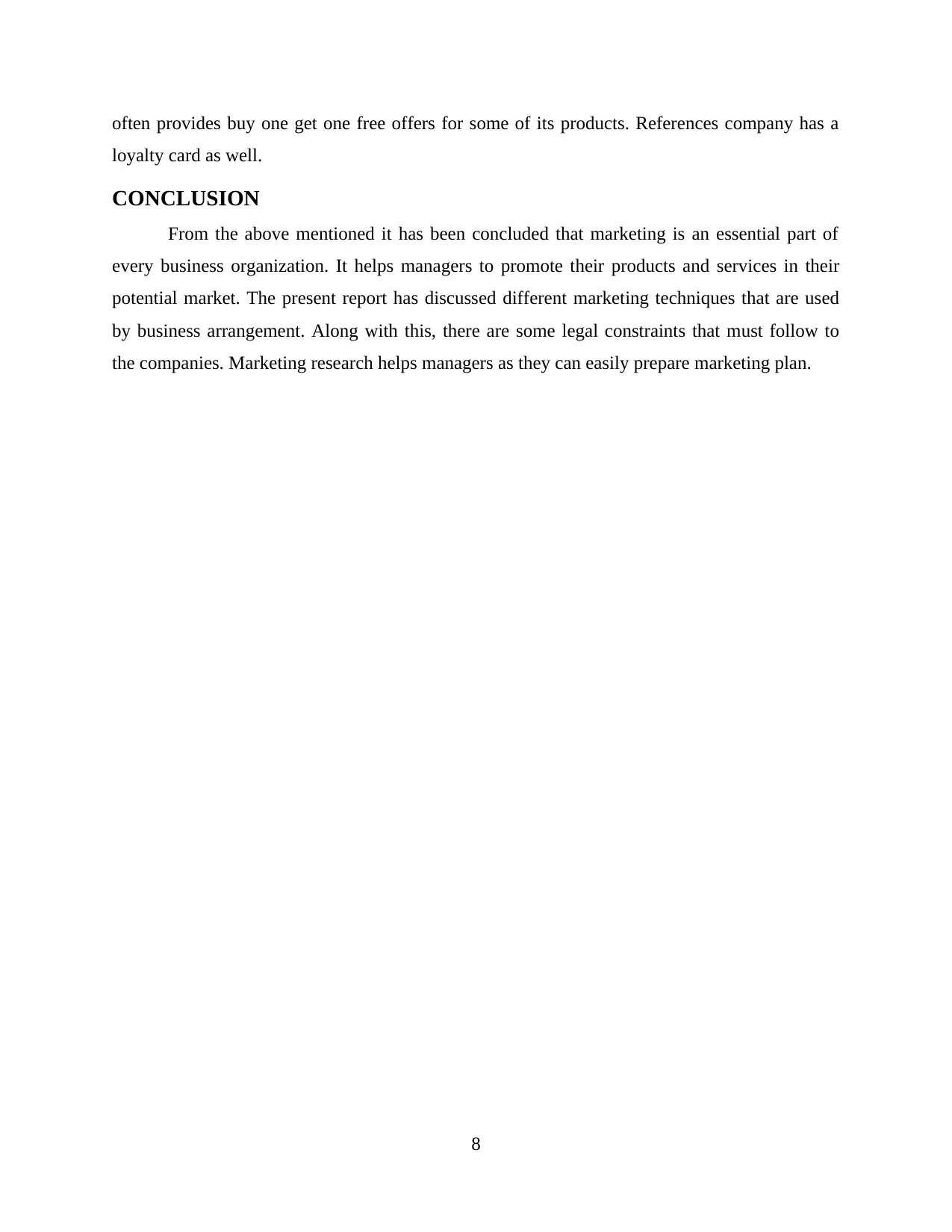
often provides buy one get one free offers for some of its products. References company has a
loyalty card as well.
CONCLUSION
From the above mentioned it has been concluded that marketing is an essential part of
every business organization. It helps managers to promote their products and services in their
potential market. The present report has discussed different marketing techniques that are used
by business arrangement. Along with this, there are some legal constraints that must follow to
the companies. Marketing research helps managers as they can easily prepare marketing plan.
8
loyalty card as well.
CONCLUSION
From the above mentioned it has been concluded that marketing is an essential part of
every business organization. It helps managers to promote their products and services in their
potential market. The present report has discussed different marketing techniques that are used
by business arrangement. Along with this, there are some legal constraints that must follow to
the companies. Marketing research helps managers as they can easily prepare marketing plan.
8
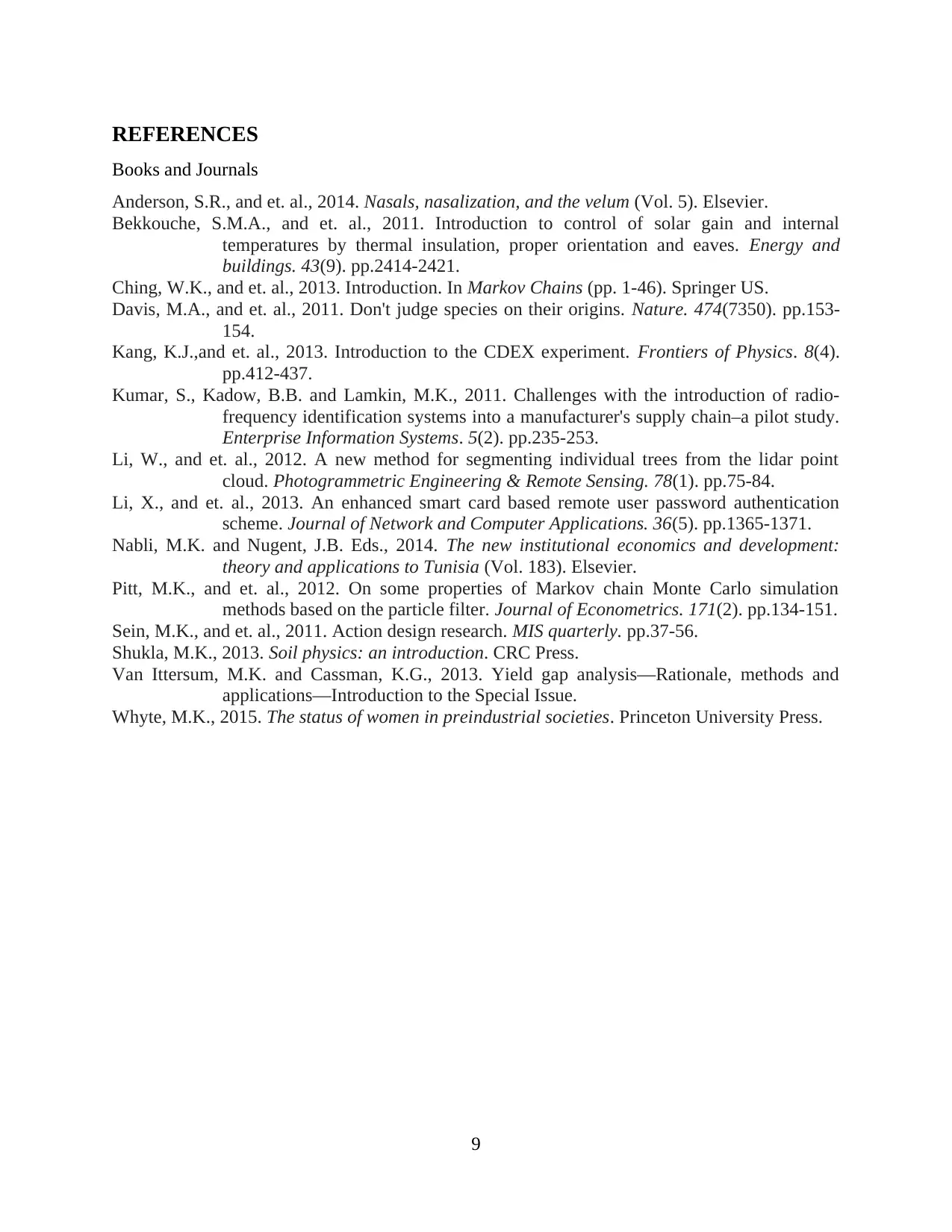
REFERENCES
Books and Journals
Anderson, S.R., and et. al., 2014. Nasals, nasalization, and the velum (Vol. 5). Elsevier.
Bekkouche, S.M.A., and et. al., 2011. Introduction to control of solar gain and internal
temperatures by thermal insulation, proper orientation and eaves. Energy and
buildings. 43(9). pp.2414-2421.
Ching, W.K., and et. al., 2013. Introduction. In Markov Chains (pp. 1-46). Springer US.
Davis, M.A., and et. al., 2011. Don't judge species on their origins. Nature. 474(7350). pp.153-
154.
Kang, K.J.,and et. al., 2013. Introduction to the CDEX experiment. Frontiers of Physics. 8(4).
pp.412-437.
Kumar, S., Kadow, B.B. and Lamkin, M.K., 2011. Challenges with the introduction of radio-
frequency identification systems into a manufacturer's supply chain–a pilot study.
Enterprise Information Systems. 5(2). pp.235-253.
Li, W., and et. al., 2012. A new method for segmenting individual trees from the lidar point
cloud. Photogrammetric Engineering & Remote Sensing. 78(1). pp.75-84.
Li, X., and et. al., 2013. An enhanced smart card based remote user password authentication
scheme. Journal of Network and Computer Applications. 36(5). pp.1365-1371.
Nabli, M.K. and Nugent, J.B. Eds., 2014. The new institutional economics and development:
theory and applications to Tunisia (Vol. 183). Elsevier.
Pitt, M.K., and et. al., 2012. On some properties of Markov chain Monte Carlo simulation
methods based on the particle filter. Journal of Econometrics. 171(2). pp.134-151.
Sein, M.K., and et. al., 2011. Action design research. MIS quarterly. pp.37-56.
Shukla, M.K., 2013. Soil physics: an introduction. CRC Press.
Van Ittersum, M.K. and Cassman, K.G., 2013. Yield gap analysis—Rationale, methods and
applications—Introduction to the Special Issue.
Whyte, M.K., 2015. The status of women in preindustrial societies. Princeton University Press.
9
Books and Journals
Anderson, S.R., and et. al., 2014. Nasals, nasalization, and the velum (Vol. 5). Elsevier.
Bekkouche, S.M.A., and et. al., 2011. Introduction to control of solar gain and internal
temperatures by thermal insulation, proper orientation and eaves. Energy and
buildings. 43(9). pp.2414-2421.
Ching, W.K., and et. al., 2013. Introduction. In Markov Chains (pp. 1-46). Springer US.
Davis, M.A., and et. al., 2011. Don't judge species on their origins. Nature. 474(7350). pp.153-
154.
Kang, K.J.,and et. al., 2013. Introduction to the CDEX experiment. Frontiers of Physics. 8(4).
pp.412-437.
Kumar, S., Kadow, B.B. and Lamkin, M.K., 2011. Challenges with the introduction of radio-
frequency identification systems into a manufacturer's supply chain–a pilot study.
Enterprise Information Systems. 5(2). pp.235-253.
Li, W., and et. al., 2012. A new method for segmenting individual trees from the lidar point
cloud. Photogrammetric Engineering & Remote Sensing. 78(1). pp.75-84.
Li, X., and et. al., 2013. An enhanced smart card based remote user password authentication
scheme. Journal of Network and Computer Applications. 36(5). pp.1365-1371.
Nabli, M.K. and Nugent, J.B. Eds., 2014. The new institutional economics and development:
theory and applications to Tunisia (Vol. 183). Elsevier.
Pitt, M.K., and et. al., 2012. On some properties of Markov chain Monte Carlo simulation
methods based on the particle filter. Journal of Econometrics. 171(2). pp.134-151.
Sein, M.K., and et. al., 2011. Action design research. MIS quarterly. pp.37-56.
Shukla, M.K., 2013. Soil physics: an introduction. CRC Press.
Van Ittersum, M.K. and Cassman, K.G., 2013. Yield gap analysis—Rationale, methods and
applications—Introduction to the Special Issue.
Whyte, M.K., 2015. The status of women in preindustrial societies. Princeton University Press.
9
⊘ This is a preview!⊘
Do you want full access?
Subscribe today to unlock all pages.

Trusted by 1+ million students worldwide
1 out of 13
Related Documents
Your All-in-One AI-Powered Toolkit for Academic Success.
+13062052269
info@desklib.com
Available 24*7 on WhatsApp / Email
![[object Object]](/_next/static/media/star-bottom.7253800d.svg)
Unlock your academic potential
Copyright © 2020–2025 A2Z Services. All Rights Reserved. Developed and managed by ZUCOL.





